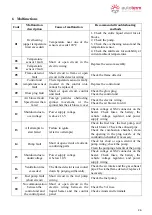
23
3.7
Installation of the control panel.
The control panel is intended for the operative control of
the heater. Install the panel in a convenient (appropriate) place
protected from water. The panel is attached using double-
sided adhesive tape or a standard bracket (Fig.29). The wire
may be brought out of the panel casing through the back cover
or the partition of the inner surface of the panel casing. Before
installation, degrease the surface where the panel is to be
installed. Remove protective film from adhesive tape and
install the panel on the prepared surface.
Never extend the cable of the control panel itself as it is transmitting a digital
signal. In the event of a bad connection, this will result in malfunctions.
Use designated control panel wiring extensions.
4
Testing the heater after installation and first launch
The heater can only be put in operation when the system has been fully installed!
After installation, check:
-
tightness of the air intake, exhaust, and fuel pipes clamps
-
tightness of the coolant system clamps
-
battery voltage
-
the secure attachment of harness’ electric contacts and heater assemblies.
Fill the main fuel line with fuel, preferably using a fuel-priming device. These can be
ordered from official dealers. When the fuel system is filled, check that the fuel supply line
is sealed.
Start the heater and check its operation in minimum and maximum modes. Check
tightness and sealing of all exhaust connections, as well as air intake and coolant pipes.
Make sure there is no air in the coolant system. Run the heater for about 2 hours.
During first time operation, the exhaust pipe might emit some smoke for a
short period of time.
The launch process of the heater starts with less than a minute-long power-on-self-test.
During that time the heater self-checks its components for errors. During this phase all
components are powered up once, which results in a single audible pump click, a short fan
burst, and internal checks of glow plug and sensors. After that it starts a phase of heating
the glow plug to remove any fuel vapours remaining from the previous work cycle. This
lasts for up to 120 seconds and is a silent process.
After the purge ends, the process of ignition starts and the continuation of the set mode.
This means that the fan will slowly start to rotate and fuel pump start to click.
Fig. 29 – Installation of the
control panel PU-27 using a
mounting bracket.














































